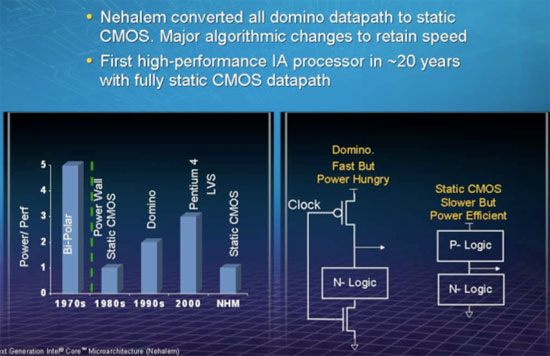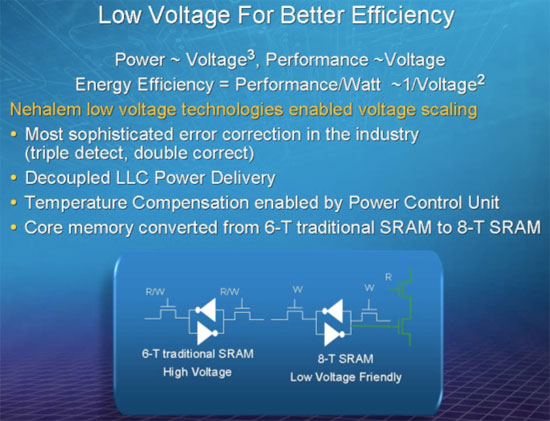The Dark Knight: Intel's Core i7
by Anand Lal Shimpi & Gary Key on November 3, 2008 12:00 AM EST- Posted in
- CPUs
Is Nehalem Efficient?
At this year's IDF in San Francisco, Intel revealed a little discussed but extremely important aspect of Nehalem's circuit design:

The Nehalem design is Intel's first microprocessor in the past two decades to feature absolutely no domino logic, it's a fully static CMOS design. I've explained the differences between dynamic domino and static CMOS design in the past, but simply put: domino logic is used as a clock speed play. It's incredibly useful in implementing very high speed circuit paths on a chip and hit its all time peak in Intel's usage in the Pentium 4 days. The downside to using such high speed logic is that it requires a lot of power, but in microprocessor design there are always tradeoffs to be made.

There are many other energy efficiency plays within Nehalem
In Nehalem, Intel took the new architecture as an opportunity to revamp its design, went in and removed all remaining domino logic - but without impacting the peak clock speed of the architecture. The tradeoff here is one of die size, by using more parallel logic Intel was able to convert some serial, high speed paths, into larger, slower circuits that removed the need for domino logic. Details are unfortunately light and a bit beyond the scope of this review, but the move to an all static CMOS design is bound to reduce power consumption. Do you smell a comparison coming?
Both Nehalem and Penryn are built on the same 45nm process, available at the same clock speeds and capable of running the very same applications. In theory, Nehalem should be more power efficient, at the same clock speed, across the board thanks to its static CMOS design. To find out I measured average power consumption over the duration of a handful of benchmarks I used in this review.
| Performance | POV-Ray 3.7 | Cinebench XCPU | x264 HD | Crysis |
| Intel Core 2 Quad Q9450 (Penryn - 2.66GHz) | 2238 PPS | 11502 CBMarks | 61.5 fps | 34.0 fps |
| Intel Core i7-920 (Nehalem - 2.66GHz) | 3528 PPS | 16211 CBMarks | 74.8 fps | 33.2 fps |
| Nehalem Performance Advantage | 57.6% | 40.9% | 21.6% | -2% |
I picked these four benchmarks because they show us the range of Nehalem's performance, going from no performance improvement all the way up to a gain of nearly 60%. Now let's look at the power consumption in each of these four benchmarks:
| Power Consumption | POV-Ray 3.7 | Cinebench XCPU | x264 HD | Crysis |
| Intel Core 2 Quad Q9450 (Penryn - 2.66GHz) | 168.1W | 175.2W | 167.5W | 220.8W |
| Intel Core i7-920 (Nehalem - 2.66GHz) | 202.2W | 208.6W | 176.6W | 230.8W |
| Nehalem Power Disadvantage | +34.1W | +33.4W | +9.1W | +10W |
If you actually go through and do the math you'll find that Nehalem, despite using more power, is more efficient than Penryn. Performance per watt is around 24% better in POV-Ray, 15.5% better in Cinebench and 13% better in the x264 HD test. Crysis, the only benchmark where Nehalem actually falls behind, does require more power and thus Nehalem loses the efficiency battle there.
It seems as if Nehalem is even more polarizing than I had though. Despite the move to a fully static CMOS design, the changes aren't enough to make up for the scenario where Nehalem can't offer more performance; power consumption still goes up, albeit not terribly.
It's also worth noting that the power comparison really depends on the CPU used, here we've got the same comparison but with the Core i7-965 vs. the Core 2 Extreme QX9770, both clocked at 3.2GHz:
| Performance | POV-Ray 3.7 | Cinebench R10 - XCPU | x264 HD | Crysis |
| Intel Core 2 Extreme QX9770 (Penryn - 3.2GHz) | 2641 PPS | 14065 CBMarks | 73.2 fps | 41.7 fps |
| Intel Core i7-965 (Nehalem - 3.2GHz) | 4202 PPS | 18810 CBMarks | 85.8 fps | 40.5 fps |
| Power Consumption | POV-Ray 3.7 | Cinebench R10 - XCPU | x264 HD | Crysis |
| Intel Core 2 Extreme QX9770 (Penryn - 3.2GHz) | 230.7W | 227.6W | 230.3W | 293.6W |
| Intel Core i7-965 (Nehalem - 3.2GHz) | 233.7W | 230.7W | 196.2W | 248.5W |
It's tough to draw any conclusions based on two CPUs, but it is possible that at higher clock speeds Nehalem's efficiency advantage kicks in. The QX9770 has always been a bit high on the power consumption side, whereas the i7-965, even in situations where it is slower than the QX9770, offers better power efficiency here.










73 Comments
View All Comments
Gary Key - Monday, November 3, 2008 - link
"The 920 to 3.6/3.8 is a nice overclock but I wonder what you mean by proper cooling and how close you came to crossing the 80C "boundary"?"It was actually quite easy to do with the retail cooler, in fact in our multi-task test playing back a BD title while encoding a BD title, the core temps hit 98C. Cinebench multi-core test and OCCT both had the core temps hit 100C at various points. Our tests were in a closed case loaded out with a couple of HD4870 cards, two optical drives, three hard drives, and two case fans.
Proper cooling (something we will cover shortly) consisted of the Thermalright Xtreme120, Vigor Monsoon II, and Cooler Master V8 along with the Freezone Elite. We were able to keep temps under 70C with a full load on air and around 45C with the Freezone unit.
Th3Eagle - Tuesday, November 4, 2008 - link
Wow, thats interesting. Can't wait to see the new article. Always nice to see an article about coolers.Thanks for the reply.
Anand Lal Shimpi - Monday, November 3, 2008 - link
Gary did the i7-920 tests so I'll let him chime in there, we're also working on an overclocking guide that should help address some of these concerns.-A
whatthehey - Monday, November 3, 2008 - link
Tom's? You might as well reference HardOCP....Okay, THG sometimes gets things right, but I've seen far too many "expose" articles where they talk about the end of the world to take them seriously. Ever since the i820 chipset fiasco, they seem to think everything is a big deal that needs a whistle blower.
Anandtech got 3.8GHz with an i7-920, and I would assume due diligence in performance testing (i.e. it's not just POSTing, but actually running benchmarks and showing a performance improvement). I'm still running an overclocked Q6600, though, and the 3.6GHz I've hit is really far more than I need most of the time. I should probalby run at 3.0GHz and shave 50-100W from my power use instead. But it's winter now, and with snow outside it's nice to have a little space heater by my feet!
The0ne - Monday, November 3, 2008 - link
TomHardware and Anandtech were the one websites I visited 13 years ago during my college years. Tom's has since been pushed far down the list of "to visit sites" mainly due to their poor articles and their ad littered, poorly designed website. If you have any type of no-script enable there's quite a bit to enable to have the website working. The video commentary is a joke as they're not professionals to get the job done professionally...visually anyhow.Anandtech has stayed true to it's root and although I find some articles a bit confusing I don't mind them at all. Example of this are camera reviews :)
GaryJohnson - Monday, November 3, 2008 - link
Geez, calling a core 2 a space heater. How soon we forget prescott...JarredWalton - Monday, November 3, 2008 - link
I think overclocked Core 2 Quad is still very capable of rating as a space heater. The chips can easily use upwards of 150W when overclocked, which if memory serves is far more than any of the Prescott chips did. After all, we didn't see 1000W PSUs back in the Prescott era, and in fact I had a 350W PSU running a Pentium D 920 at 3.4 GHz without any trouble. :-)Griswold - Tuesday, November 4, 2008 - link
Funny comparison. If it was just for the space heater arguments sake (well, 150W is by far not enough to qualify as a real space heater to be honest), I could follow you but saying the 150W of a 4 core, more-IPC-than-any-P4-can-ever-dream-of, processor should or could be compared to the wattage of the infamous thermonuclear furnace AKA prescott, is a bit of a long stretch, dont you think? :pRyan Smith - Monday, November 3, 2008 - link
Intel can call it supercalifragilisticexpialidocious until they're blue in the face, but take it from a local, it's Neh-Hay-Lem. Just see how it's pronounced in this news segment:http://www.katu.com/outdoors/3902731.html?video=YH...">http://www.katu.com/outdoors/3902731.html?video=YH...
mjrpes3 - Monday, November 3, 2008 - link
Any chance we'll see some database/apache benchmarks based on Nehalem soon?